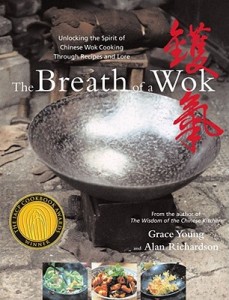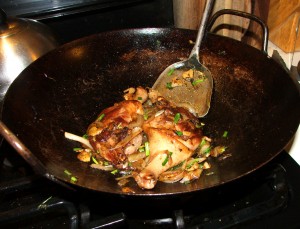One Wok to Rule the Kitchen
 THE BREATH OF A WOK
THE BREATH OF A WOK
Unlocking the Spirit of Chinese Wok Cooking Through Recipes and Lore
by Grace Young and Alan Richardson
Simon & Schuster
240 pp. $35.00
One wok runs to the sky’s edge
—Traditional saying
These are the first words you will come to in the book The Breath of a Wok by Grace Young. I like this saying, though I’m not sure what it means. I do know, however, that the word one seems important to understanding its meaning. Not in the sense that there is one wok in particular that has the ability to run to the sky’s edge (as in the Tolkien saying “one ring to rule them all”), but that all that is needed to do the job is one wok. In a wok, just one wok, you can do it all: stir-fry, pan-fry, deep-fry, steam, poach, boil, braise, smoke . . . run to the sky’s edge.
An appreciation for the amazing versatility of the wok is one of several take-aways available to cooks and readers between the covers of The Breath of a Wok, which is so much more than a Chinese cookbook. In a nutshell, it is an engaging read about the pleasures and efficiency of wok cooking accompanied by home-style recipes and colorful photos depicting not just woks and the gorgeous foods prepared in them, but also the people who make, repair, and use woks.
To document wok culture first-hand, author Grace Young and photographer Alan Richardson travel first to Hong Kong and then on to China where they interview, photograph, and/or share meals with home cooks, street hawkers, chefs, and remaining wok makers and repairman. Remaining because the availability of cheap, factory-made woks is slowly making the hand-made wok, and those who repair them, a near relic of the past. Young writes in the first pages of Breath of her dismay at finding just whispers of the wok culture she’d encountered decades earlier in Hong Kong: “The intent of my trip was to observe the many facets of wok culture, but instead it feels like I’m documenting its last vestiges. It seems all the more important to locate as much traditional wok culture as I can, recording it before it becomes extinct.”
Once in China, however, Young finds there is thankfully still wok culture to discover and document. Pulling stories, recipes, and images as they go, the writer-photographer team find captivating material that becomes the basis for several enlightening and beautifully illustrated sidebars in the book ranging in topic from “Wok Hay: The Breath of a Wok” to “The Face of a Wok,” “The Wok Warriors,” and “Opening a Wok,” which is all about seasoning a new wok.
Back home in the United States, the stories, recipes, and photos are culled from family members, friends, and esteemed cooks and published authors, such as Florence Lin, who has long taught Chinese cooking to Americans.

This is one of member Jennifer Megyesi’s favorite dishes from BREATH: Cousin Sylvia’s Drumsticks with Caramelized Onions, which she made with duck. Her extremely well seasoned wok is 25 years old—something her husband brought to their household and that she has been using ever since. (Photo©Jennifer Megyesi)
The pride taken in a well-seasoned wok is one of the pleasures of wok cooking. A good patina is not only beautiful—it helps food cook better (it’s nature’s non-stick surface) and contributes to the wok hay of a dish. Young includes a trove of “recipes” for seasoning a new wok, including her favorite method for using Chinese chives and vegetable oil.
Inspired by the book, Bev Morrow, a DCCC member in Denver, Colorado, took her Teflon-coated wok to Goodwill and bought a flat-bottomed hammered wok. To build up a patina as quickly as possible, she used the wok instead of a skillet and left it on the stovetop to remind her to use it. If you become obsessed with seasoning your new wok, as I have, you may even find yourself deciding what dishes to make based on their likelihood of helping or eroding your wok’s patina. (For example, stir-fried or pan-fried dishes, especially meat, are good options when first building your wok’s patina, which will be fragile at first. Avoid steaming or boiling in your wok, or making dishes that have acid in them.)
Once you’ve seasoned your new wok, the best way to build up a patina is to use it—at least once or twice weekly. For this purpose, you’ll find 125 recipes in Breath, the majority of which are easy-to-make home-style Cantonese dishes from home cooks, friends, and family members. Appropriately, the dishes in Breath taste like home cooking—what I imagine to be the equivalent of Chinese comfort food: fresh, simple, clean, bright, and satisfying.
To have success with the recipes in Breath, which are restrained in the use of seasoning and condiments (to read more about Cantonese-style cooking click here), it’s important to use very fresh, seasonal produce and good quality meats and ingredients. (Remember: Unlike typical Chinese-American restaurant food, there’s no MSG here to boost flavor and thereby camouflage lesser quality ingredients.) RICE WINE ALERT: Outside of Asian markets in large cities, it is very difficult to find good quality Chinese rice wine. Rather than use an inferior Chinese rice wine (it should not be labeled “cooking wine”), you’re better off using dry sherry.
Below is a list of some of our favorite recipes from The Breath of a Wok. If you’ve purchased a new wok, seasoned it, but haven’t had a chance to pick up ingredients to make a recipe from Breath, here’s a tip to get you started: Make popcorn. It turns out perfectly with a HUGE popped to unpopped ratio, and it will help to season your wok beautifully. Of course you’ll need a wok lid, so all the more reason to purchase one when you purchase your wok.
Favorite recipes randomly sampled by DCCC members:
Susanna Foo’s Mango Chicken
Jean Yueh’s Shanghai-Style Shrimp (This is DCCC member Bev Morrow’s favorite. She and her daughter stood at the island in the kitchen and downed half the shrimp straight from the pan! [Bev’s exclamation point.])
Cousin Kathy’s Lion’s Head (The “lion’s head” refers to huge, tender meatballs [made with ground pork] with a cabbage “mane.”)
Uncle Lang’s Three Teacup Chicken
Walter Kei’s Shanghai-Style Pork and Bean Sprouts
Stir-Fried Chicken and Shallots
Che Chung Ng’s Scallops with Asparagus
Cousin Sylvia’s Drumsticks with Caramelized Onions
Henry Hugh’s Cantonese Stuffed Tofu
Uncle Lang’s Oyster Sauce Mushroom
Spicy Garlic Eggplant (This is the only dish DCCC member Marianne made. But she liked it so much that she kept making it again and again.)
Amy Tan’s Family’s Jiao-zi with Jin Do’s Tangy Ginger Sauce
Chicken with Sichuan Peppercorns
Virginia Yee’s Dry-Fried Sichuan String Beans
Margaret Loo’s Braised Tofu and Mushrooms
Florence Lin’s Tofu with Cilantro Relish
